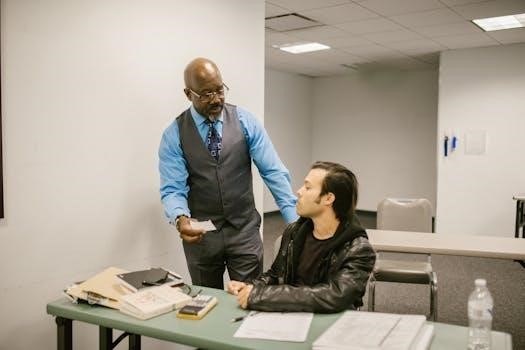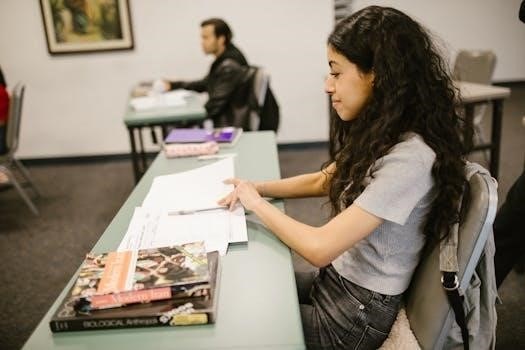clt test questions and answers pdf
CLT Test Overview
The Classic Learning Test, developed as an alternative to the SAT and ACT, assesses intellectual aptitude, achievement, and moral reasoning, focusing on logic, reason, and reading. It aims to address bias issues found within other standardized tests.
What is the CLT?
The Classic Learning Test (CLT) is a college entrance exam designed to evaluate a student’s critical reasoning skills. It provides an alternative to traditional tests like the SAT and ACT, emphasizing classical educational values and engagement with influential historical texts. The CLT focuses on assessing intellectual aptitude, achievement, and moral reasoning, particularly through logic, reason, and reading comprehension. It was developed in 2015 to address perceived biases in the SAT and ACT delivery methods. The test is structured into three main sections, including verbal reasoning, grammar and writing, and quantitative reasoning, each with 40 questions. The CLT utilizes a simple and balanced design, with reading passages and questions. This exam is suitable for students seeking an assessment that emphasizes a traditional education path and critical thinking skills, moving away from trend-based educational systems. It also offers a practice test that is graded and gives recommendations on what to study in preparation for the real test. The CLT is available for students from grades 3 through 12.

CLT Exam Sections
The CLT exam is divided into three main sections⁚ Verbal Reasoning, Grammar and Writing, and Quantitative Reasoning. Each section contains 40 questions, designed to assess critical skills.
Verbal Reasoning
The Verbal Reasoning section of the CLT evaluates comprehension and reasoning through engagement with literature, philosophy, and historical texts. This section consists of 40 questions and includes exactly four reading passages, each followed by ten questions. It assesses a student’s ability to understand complex texts, identify main ideas, and draw logical inferences. The questions in this section often require close reading and an understanding of the nuances of language. Success in this area highlights a student’s capacity for critical thinking and their ability to engage with classical educational materials, making it a critical component of the overall CLT assessment which tests intellectual aptitude and moral reasoning. It is an important part of the test that emphasizes classical educational values.
Grammar and Writing
The Grammar and Writing section of the CLT assesses a student’s command of English grammar and their ability to write clearly and correctly. This section contains 40 questions and includes four reading passages, each with ten questions. It tests grammar usage and sentence analysis, focusing on correctness and clarity. Students are required to identify and correct errors in sentence structure and grammar. This part of the exam emphasizes the importance of precise communication, reflecting the focus of the test on critical thinking and analytical skills. It also incorporates elements of classical education, aiming to evaluate a student’s capability to use language effectively and accurately for academic purposes. Success in this section demonstrates proficiency in fundamental linguistic skills.
Quantitative Reasoning
The Quantitative Reasoning section of the CLT evaluates a student’s mathematical aptitude across several areas. It includes 40 questions and is broken into three sub-sections, focusing on algebra, geometry, and mathematical reasoning. The algebra sub-section tests understanding of algebraic equations, inequalities, and expressions. The geometry sub-section assesses knowledge of geometric shapes, properties, and reasoning. The mathematical reasoning sub-section focuses on logical problem-solving and data interpretation, going beyond algebra and geometry. This part of the exam emphasizes analytical and critical thinking skills in a mathematical context, reflecting the CLT’s overall aim to evaluate a student’s problem-solving abilities. It requires students to apply mathematical concepts effectively to solve problems.

CLT Practice Resources
To prepare for the CLT, utilize free online practice tests to familiarize yourself with the software and question types. Also, use specialized quizzes for targeted study to focus on specific areas.
Free Online Practice Tests
Accessing free online practice tests is a crucial step in preparing for the Classic Learning Test (CLT). These tests offer a valuable opportunity to familiarize yourself with the exam’s structure, question formats, and time constraints. Many platforms provide full-length practice tests that mimic the actual CLT, enabling you to experience the testing environment firsthand. These resources often include a variety of questions, allowing you to gauge your understanding across different subjects. Some platforms offer immediate results and answer explanations, helping you pinpoint areas for improvement. By taking advantage of these free practice tests, you can enhance your preparation and build confidence before the actual exam. Remember that consistent practice is key to success, and these resources are readily available to support your study efforts.
Specialized Quizzes for Targeted Study
To further enhance your preparation for the Classic Learning Test (CLT), consider utilizing specialized quizzes designed for targeted study. These quizzes are meticulously crafted to concentrate on specific elements of the CLT, allowing you to focus your efforts on areas where you need the most improvement. By engaging with these targeted quizzes, you can address your weaknesses and solidify your understanding of core concepts. They provide a more focused approach compared to full-length practice tests, enabling you to refine your skills in areas like verbal reasoning, grammar and writing, and quantitative reasoning. This method of study helps you to manage your time better and ensure that you are fully prepared for the specific challenges of the CLT. The quizzes will also give you a deeper understanding of the questions and types of formats you can expect on the day of the exam.

CLT Test Preparation
Effective preparation involves understanding the test structure, utilizing practice resources, and adopting sound study strategies. A multi-faceted approach, focusing on weak areas, is key for success on the CLT.
Understanding Test Structure
The Classic Learning Test is comprised of three main sections⁚ Verbal Reasoning, Grammar and Writing, and Quantitative Reasoning, each containing 40 questions. There is also an optional essay component. The Verbal Reasoning section evaluates comprehension and reasoning skills using literature, philosophy, and historical texts. The Grammar and Writing section assesses grammar usage and sentence analysis. The Quantitative Reasoning section focuses on mathematical skills, including algebra, geometry, and logical problem-solving. Each Verbal Reasoning and Grammar/Writing section incorporates four reading passages, each with ten questions. Familiarizing yourself with this structure, including the number of questions per section and the types of content, is essential for effective test preparation. Understanding the test’s format and content allows students to tailor their study plans, ensuring they focus on the areas most relevant to their success. Knowing the design of the exam with its balanced number of questions can help with time management during the test.
Effective Study Strategies
To effectively prepare for the Classic Learning Test, a multi-faceted approach is recommended, combining understanding the test structure with frequent practice and mastery of test-taking strategies; Begin by reviewing the test format, noting the number of questions per section and the types of content covered, which includes Verbal Reasoning, Grammar/Writing, and Quantitative Reasoning. Use practice tests to identify areas of strength and weakness, allowing you to tailor your study plan. Focus on targeted practice, utilizing specialized quizzes that concentrate on specific elements of the CLT, especially in areas needing improvement. Learn from mistakes by reviewing answer explanations, particularly for questions you answered incorrectly or guessed on. Write down answers to questions, using a timer to simulate test conditions. Engage with resources such as study guides, online practice tests, and third-party materials to broaden your knowledge base. Ensure you allocate sufficient time to study each of the test sections.

CLT Costs and Fees
The primary cost is a 59 registration fee, which includes student analytics and unlimited score sharing with colleges. Additional expenses may include study materials and potential tutoring services.
Registration Fee
The registration fee for the Classic Learning Test (CLT) is a fixed cost of $59. This fee is comprehensive, covering several essential services that are beneficial for test-takers. Included in this fee are detailed student analytics, which provide insights into performance across different sections of the test. These analytics help students understand their strengths and areas needing improvement. Furthermore, the registration fee allows for unlimited score sharing with colleges. This feature is particularly valuable as it enables students to send their scores to as many institutions as they wish, without incurring additional costs for each submission. This streamlined approach helps to simplify the college application process for students and their families. The $59 registration fee is a one-time payment that covers all of these services.
Additional Expenses
While the registration fee covers the core testing services, prospective test-takers may encounter additional expenses related to preparation and study materials. These costs can fluctuate significantly depending on the resources chosen by the student. For example, study guides and practice tests, whether digital or physical, often come with their own price tags. These are designed to help students familiarize themselves with the test format and question types. Furthermore, students may opt for tutoring services, which can be quite expensive depending on the tutor’s experience and qualifications. While the official CLT website does offer resources on test content, third-party vendors also provide practice tests and study guides, and the costs for these resources can vary widely. It is important for students to consider these potential additional expenses when planning for the CLT.
Leave a Reply